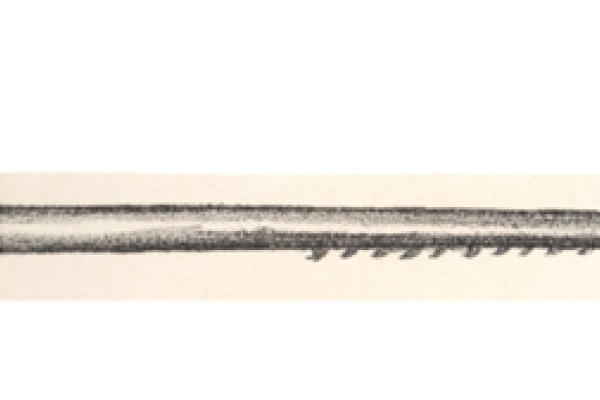New names for fossil sharks: News from the Orton Museum

The Carboniferous Period (359–200 million years ago) is known as the “Age of Coal Swamps” and the “Age of Sharks.” And Ohio’s Carboniferous rocks are rich in both coal formed in these swamps and fossil sharks that lived in the fresh or brackish water of the “coal swamps.” One of the most intriguing sharks of that time was the giant Orthacanthus. With an elongate eel-like body, a long dorsal fin extending the length of its back, and a peculiar spine extending backward from the head, the 3-meter-long Orthacanthus was one of the most terrifying inhabitants of freshwater swamps and bayous in ancestral North America and Europe. It fed on fishes and tetrapods. Orthacanthus belongs to an extinct group of chondrichthyans (which includes sharks, skates, and rays) called the xenacanthiforms.
Orthacanthus is the subject of a new paper (https://doi.org/10.3897/zookeys.1188.108571) stemming from new work on the fossil fishes in the collection of the Orton Geological Museum. For many years, three different species were all known by the same species name, Orthacanthus gracilis. There was one species called O. gracilis described from the Carboniferous of Germany, one species of the same name described from Linton, Ohio, and another species of the same name also described from Linton, Ohio. The homonymy of names introduced unnecessary confusion into the literature. Because the species from Germany was described first, it has priority according to international convention, and new names were proposed for the two species from Ohio. The confusion about the names of these three shark species has now been solved.
The type, or name-bearing, specimens of the newly renamed shark species are part of the extensive collection of Devonian and Carboniferous fish fossils from Ohio assembled and originally studied by John Strong Newberry (1822–1892). Between 1869 and 1882, Newberry served as Chief Geologist of the Geological Survey of Ohio. One of the Assistant Geologists under Newberry at that time was Edward Orton who, in 1873, was hired as the first President and Professor of Geology at the Ohio Agricultural and Mechanical College (renamed The Ohio State University). This connection between Newberry and Orton was instrumental in Orton’s initial development of the university’s geological collection. Beginning in 1873, the Geological Survey of Ohio published summary reports of the geology and paleontology of Ohio. These beautifully illustrated volumes contain descriptions of many of the Paleozoic fossils known from within the state and from adjacent areas. Shortly after the first volumes were published, specimens in the possession of the Geological Survey began to be transferred to The Ohio State University’s Geological Museum (renamed the Orton Geological Museum). Among those specimens received by Ohio State were the type specimens of Orthacanthus gracilis Newberry, 1875, which is now known as Orthacanthus adamas. Prior to 1874, many of Newberry’s fossil fishes had been reposited in Columbia University’s School of Mines; they are now in the American Museum of Natural History, in New York City.

Tooth of the xenacanthiform shark Orthacanthus lintonensis Babcock, 2024, left, and dorsal spine of Orthacanthus adamas Babcock, 2024, right, both from the Upper Freeport Coal (Carboniferous) of Linton, Ohio. Modified from Babcock (2024), after Newberry (1875). The tooth is ca. 13 mm long, and the spine is ca. 71 mm long.
